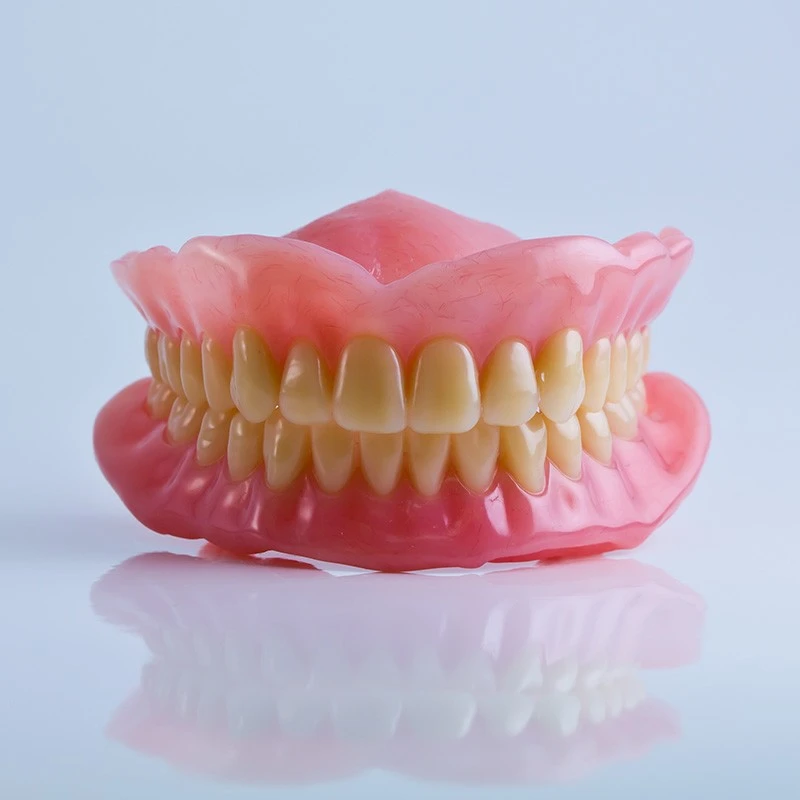
Removable dentures
Removable dentures are artificial teeth that are used to replace missing natural teeth. including adjacent tissues made from nickel-chromium alloy, titanium, or acrylic resin.
Advantages of removable dentures
- Can replace many missing teeth.
- Can replace and cure fever in cases where there are gums and many bones are missing.
- Cheaper than fixed dentures
- In the case where the primary teeth are not strong, Unable to make dentures firmly fixed
- Used as a temporary denture while waiting for other treatments. or help evaluate beauty and the use of fixed dentures.
Types of removable dentures
- Full-mouth removable dentures This type of prosthetic tooth is used for patients who have lost all of their teeth. Or are there only a few teeth left? (Usually no more than six teeth.) If natural teeth are missing in only one jaw, It is called a single-denture set.
- Removable partial dentures Removable partial dentures are used to replace many of the of the natural teeth remaining. They can be made from metal. They are called metal-base removable partial dentures. If they are made from acrylic resin, they are called acrylic removable partial dentures. Or some types are made from nylon, which is highly flexible. But there are still limitations to its use. Which type of prosthetic tooth will be used depends on the patient's teeth, economic status, and purpose.
- Immediate dentures This type of denture is often used as a temporary denture. In cases where many teeth need to be extracted or long-term removable dentures In cases where a few teeth are extracted, the dentist will prepare the artificial teeth first. Then make an appointment for the patient to have the tooth extracted along with dental implants immediately after the tooth is extracted. On the day of extraction, the patient must wear dentures at all times. And the denture base—artificial teeth—will need to be added 1–2 months after the tooth is extracted.
- Root dentures This type of removable denture has a natural tooth root. or dental implants combined with attachments to help hold the denture firmly in the mouth. In some cases, there may be metal rods attached to help support the force of chewing.
Procedure for making removable dentures
Removable dentures take anywhere from 1 to 6 weeks to make, depending on the type. and the difficulty of each individual After wearing removable dentures Must rely on the adjustment and cooperation of patients so that the body will accept the artificial teeth because they are new. In cases where adjustment is not possible, wearing removable dentures will not be successful. The steps and methods for making them can be summarized as follows:
- Step 1: Examination and evaluation of oral conditions First, the dentist will examine and evaluate the condition of the teeth, bite, gums, and root supporting bone. Patient's expectations, shape, and color of teeth. Then, X-rays will be taken of the teeth that are expected to be the primary teeth. Take a mouth mold to make a tooth model.
- Step 2: Plan treatment After a detailed diagnosis, the dentist will make a detailed treatment plan. Position of denture hooks Type of tooth to be waxed To evaluate the shape of the artificial teeth that will be given to the patient. Including planning to trim the main teeth to accommodate the denture hooks.
- Step 3: final mouth impression After that, the final impression will be made. In the case where primary teeth need to be trimmed, it will be done before the final impression. The impressions will then be used to make a denture frame.
- Step 4: Testing the tooth: The dentist will test the bite stick made from wax. and arrange the teeth to try on for the patient to evaluate the shape, color, and arrangement of the artificial teeth, bulgeiness of the face, and occlusion for further use in dental prostheses.
- Step 5: Putting in artificial teeth After the patient is satisfied with the dentures that were presented to them, the dentist will bring them back to make the real dentures. and put it on the patient. After inserting, there will be a point. or a painful position. This is because there may be errors in making artificial teeth. The dentist will make an appointment for the patient to come back and wait for the make-up. and continue to cure denture fever. It depends on the adjustment and cooperation of patients. In most cases, it takes 1 week to 2 months, especially in cases where there are no abutment teeth at the back. It will make wearing artificial teeth even more difficult. and patient adjustment is more difficult.
Caring for and maintaining dentures (removable dentures)
- Remove and clean every time. After eating, there should be a container to hold water to protect the dentures from falling out and breaking.
- Brush your teeth and clean your remaining natural teeth. The dentures—artificial teeth—must be removed first.
- Do not use a toothbrush. And toothpaste with abrasive powder to clean dentures - dentures because it will cause small scratches, causing dentures - dentures to wear out, stain easily and be a place for microorganisms to accumulate. Soapy water and gauze can be used to clean dentures - dentures are sufficient.
- Do not wear dentures; lying dentures should be removed and cleaned. And soak it in water. Wearing dentures while lying down will cause the accumulation of fungi. Can cause inflammation of the lining of the mouth.
- Should be checked regularly. This is because the bone ridge will dissolve, causing the dentures to tip over. Friction against oral tissue causes gingivitis. Bone wound and prolapsed tissue, fungus, causing damage to the abutment teeth in some cases, it may develop into cancer.
- Dentures should be replaced every 2–5 years.
- Dentures should not be removed; they should be left to dry, near heat, or dropped and hit. Because it will cause the artificial teeth to become deformed. Unable to put it in place.

